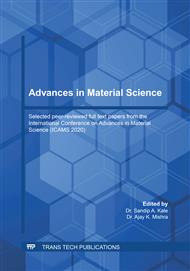[1]
Т.B. Tulendinov, А. Zesers,V. Tamužs Behavior of Concrete Cylinders Strengthened with a Basalt-FRP and Subjected to Mechanical Loads and Elevated Temperatures, Mechanics of Composite Materials, 2017, V. 53, pp.471-478.
DOI: 10.1007/s11029-017-9676-6
Google Scholar
[2]
V.A. Tarasov, N.A. Stepanishchev, R.P. Boyarskaya Technique for the experimental determination of the characteristic moments of time of the technological process of preparing nanosuspensions under ultrasonic exposure, Vestnik MGTU im. N.E. Bauma-na. Ser. Mechanical engineering. Specialist. no. Power and transport machine building,, 2011, pp.53-65.
Google Scholar
[3]
R. Koshani, S.M. Jafari Ultrasound-assisted preparation of different nanocarriers loaded with food bioactive ingredients, Advances in Colloid and Interface Science, 2019, Vol. 270, pp.123-146.
DOI: 10.1016/j.cis.2019.06.005
Google Scholar
[4]
C. Olmo, L. Franco, L.J. del Valle, J. Puiggalí Preparation of medicated polylactide mi-cropieces by means of ultrasonic technology, Applied Sciences, Switzerland, 2019, v. 9, Issue 11,p.17.
DOI: 10.3390/app9112360
Google Scholar
[5]
S. He, X. Tan, X. Hu, Y. Gao, Effect of ultrasound on oil recovery from crude oil containing sludge, Environmental Technology, United Kingdom, 2019, v. 40, Issue 11, pp.1401-1407.
DOI: 10.1080/09593330.2017.1422553
Google Scholar
[6]
S. Lin, S. Shams, H. Choi, D. Meng, H. Azari Estimation of wave velocity for ultrasonic imaging of concrete structures based on dispersion analysis, Journal of Testing and Evaluation, 2020, v. 48, Issue 2.
DOI: 10.1520/jte20180343
Google Scholar
[7]
G.V. Malysheva, V.A. Nelyub, I.V. Bessonov, Yu.A. Kurganova Study of technological processes for obtaining polymer composite materials: a tutorial, Moscow: Izd-vo MGTU im. N.E. Bauman (National Research University), 2016, p.44.
Google Scholar
[8]
V.A. Tarasov, N.A. Stepanishchev, V.A. Romanenkov, A.I. Alyamovsky Improving the quality and manufacturability of the polyester matrix of composite structures based on ultrasonic nanomodification, Vestnik MGTU im. N.E. Bauman. Ser. Machine-building, 2012, pp.166-174.
Google Scholar
[9]
G.I. Yakovlev, Yu.O. Mikhailov, Yu.N. Ginchitskaya, O. Kizinievich, P.A. Taybakhtina, Yu.A. Balobanova Building ceramics modified with dispersions of multilayer carbon nanotubes, Building materials, 2017, No. 1-2, pp.10-13.
Google Scholar
[10]
S.V. Leontiev, V.A. Shamanov, A.D. Kurzanov, G.I. Yakovlev Multicriteria optimization of the composition of heat-insulating autoclaved aerated concrete modified with a dispersion of carbon nanotubes, Stroitel'nye materialy, 2017, No. 1-2, pp.31-40.
Google Scholar
[11]
V.A. Tarasov, N.A. Stepanishchev Application of nanotechnology for hardening a polyether matrix, Vestnik MGTU im. N.E. Bauman. Ser. Mechanical engineering. Specialist. no. Actual problems of the development of missile defense and weapon systems.,, 2010, pp.207-217.
Google Scholar
[12]
V.S. Puzakov, Development and analysis of functional capabilities of ultrajet activation of hydrotechnological media for machining production, Dis. Ph.D. —M .: MSTU im. N.E. Bauman, Moscow, (2007).
Google Scholar
[13]
Ishfaq K, Ahmad N, Mufti N A, Saleem M Q, Al-Ahmari A M 2019 Abrasive Waterjet Cutting of Clad Composite for Achieving Minimal Cut Quality Difference Between Constituent Layers J Metals 9(7):754 DOI10.3390/met9070754.
DOI: 10.3390/met9070754
Google Scholar
[14]
D.R. Mugla, A.L. Galinovskiy, N.V. Kobernik Selection of rational technological modes and parameters of underwater waterjet cutting. Lecture Notes in Mechanical Engineering, 2019, pp.267-276.
DOI: 10.1007/978-3-319-95630-5_29
Google Scholar
[15]
H Kmec J, Harnicarova M, Borzan C, Borzan M, Valicek J, Kriz J, Kusnerova M 2019 Proposal for a method of measurement and control of surface quality in the course of abrasive waterjet cutting of material J MATEC Web of Conf 299:02003 DOI10.1051/matecconf/201929902003.
DOI: 10.1051/matecconf/201929902003
Google Scholar
[16]
A.A. Barzov, V.V. Veltischev, A.L. Galinovskiy D.R. Mugla, Kinetic analysis of the mechanism of self-oscillations of the mass concentration of dispersed-solid-phase particles in a hydro-ultrastroy, Izvestia of higher educational institutions, Mechanical engineering, 2018, No. 1, pp.55-62.
Google Scholar
[17]
Kyaw Myo Htet, A.L. Galinovskiy, A. S. Provatorov, To the Question of Efficiency of Different Methods of Dispersion of Nanosecuring Suspensions, Materials Science Forum, 2020, vol. 990, pp.139-143.
DOI: 10.4028/www.scientific.net/msf.990.139
Google Scholar
[18]
Jay G. Sanjayan and Behzad Nematollahi, 3D Concrete Printing for Construction Applications, Chapter 1, (2019).
Google Scholar
[19]
R. Dodge Woodson, Concrete Materials, Concrete Portable Handbook, chapter 2, pp.5-18.
Google Scholar
[20]
A. Synopsis, Nanotechnology in Concrete Materials, Transportation Research Circular, (2012).
Google Scholar


